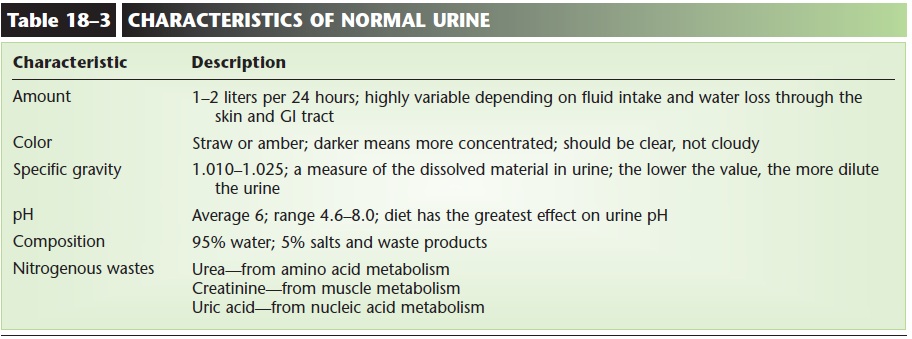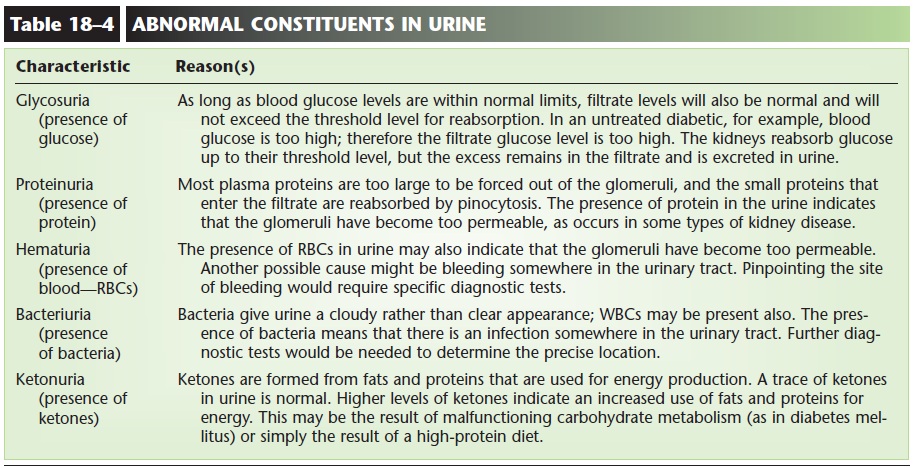Chapter: Essentials of Anatomy and Physiology: The Urinary System
Characteristics of Urine
CHARACTERISTICS OF URINE
The characteristics of urine include the physical and chemical aspects that are often evaluated as part of a urinalysis. Some of these are described in this section, and others are included in Appendix D: Normal Values for Some Commonly Used Urine Tests.
Amount—normal urinary output per 24 hours is 1 to 2 liters. Many factors can significantly change output. Excessive sweating or loss of fluid through diarrhea will decrease urinary output (oliguria) to conserve body water. Excessive fluid intake will increase urinary output (polyuria). Consumption of alcohol will also increase output because alcohol inhibits the secretion of ADH, and the kidneys will reabsorb less water.
Color—the typical yellow color of urine (from urochrome, a breakdown product of bile) is often referred to as “straw” or “amber.” Concentrated urine is a deeper yellow (amber) than is dilute urine. Freshly voided urine is also clear rather than cloudy.
Specific gravity—the normal range is 1.010 to 1.025; this is a measure of the dissolved materials in urine. The specific gravity of distilled water is 1.000, mean-ing that there are no solutes present. Therefore, the higher the specific gravity number, the more dis-solved material is present. Someone who has been exercising strenuously and has lost body water in sweat will usually produce less urine, which will be more concentrated and have a higher specific gravity.
The specific gravity of the urine is an indicator of the concentrating ability of the kidneys: The kid-neys must excrete the waste products that are con-stantly formed in as little water as possible.
pH—the pH range of urine is between 4.6 and 8.0, with an average value of 6.0. Diet has the greatest influence on urine pH. A vegetarian diet will result in a more alkaline urine, whereas a high-protein diet will result in a more acidic urine.
Constituents—urine is approximately 95% water, which is the solvent for waste products and salts. Salts are not considered true waste products because they may well be utilized by the body when needed, but excess amounts will be excreted in urine.
Nitrogenous wastes—as their name indicates, all of these wastes contain nitrogen. Urea is formed by liver cells when excess amino acids are deaminated to be used for energy production. Creatinine comes from the metabolism of creatine phosphate, an energy source in muscles. Uric acid comes from the metabolism of nucleic acids, that is, the breakdown of DNA and RNA. Although these are waste prod-ucts, there is always a certain amount of each in the blood. Blood Tests and Kidney Function describes the relationship between blood levels of these waste products and kidney function.
Other non-nitrogenous waste products include small amounts of urobilin from the hemoglobin of old RBCs (see Fig. 11–4), and may include the metabolic products of medications. Table 18–3 summarizes the characteristics of urine.

When a substance not normally found in urine does appear there, there is a reason for it. The rea-son may be quite specific or more general. Table 18–4 lists some abnormal constituents of urine and possible reasons for each.

Related Topics